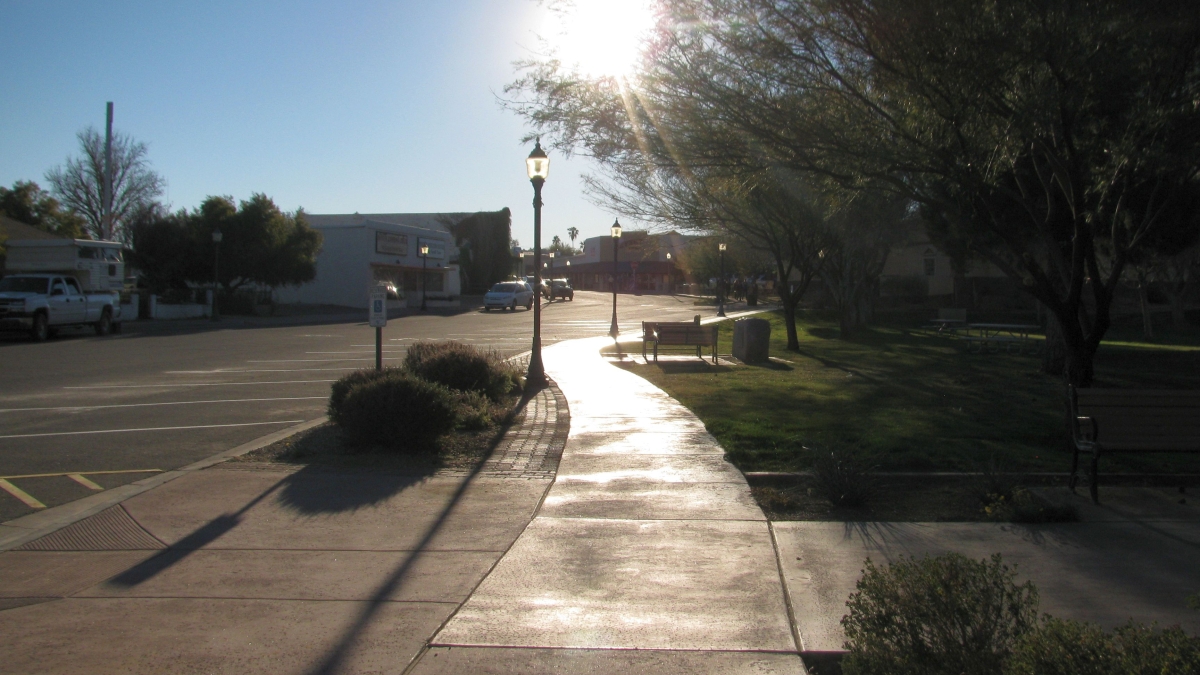Students offer new ideas for redevelopment in a classic Western town

Sixty miles northwest of Phoenix, the town of Wickenburg sits in the northern Sonoran Desert. Founded in 1863, Wickenburg was one of Arizona’s early mining towns. Residents today take pride in the town’s wide-open spaces, Western hospitality and clean air.
Modern Wickenburg has a population of around 6,500 people, and the town’s heritage plays a role in the economic and social life of the community. However, Wickenburg faces some significant economic hurdles today. According to the 2010 US Census, only about 642 people both live and work in Wickenburg; around 1,700 people reside in the town, but work outside of the community.
Students from Arizona State University’s Master of Urban and Environmental Planning (MUEP) program recently partnered with the Town of Wickenburg to address some of the community’s challenges. The second-year students prepared a comprehensive 200 page planning report, the “Wickenburg Downtown Heritage Plan,” which offered economic development, growth policy and design concept recommendations for the town.
Joochul Kim, associate professor in ASU’s School of Geographical Sciences and Urban Planning, supervised the work of the student team. The team, comprised of fifteen students, took on the Wickenburg Downtown Heritage Plan as their capstone project – a semester-long, team-based final project.
According to Wickenburg town manager, Joshua Wright, partnering with the ASU students enabled the town to receive a professional quality planning report at an affordable rate. Wright said the final report that the students presented to the town council showed an understanding of the town’s unique characteristics.
“Wickenburg has a unique downtown that the citizens and tourists enjoy, but is also susceptible to the pressures of modernization,” said Wright. “The students worked diligently to prepare a plan which will have a direct positive effect on the future growth of the downtown in Wickenburg,” Wright added.
As part of the planning process, students completed an inventory of businesses in the downtown, providing insight into which business sectors the town might concentrate on for maximum economic growth. The inventory also offered a view of which areas in Wickenburg had less commercial concentration, and thus could host future development. In addition to the business inventory, students also employed a public participation plan so as to involve Wickenburg residents in the planning process.
Joshua Matthews, a member of the student planning team, said that a public workshop and an online community survey provided essential information for the planning team’s work.
“The residents are the ones who will have to live with the outcomes of the plan. Planners just help provide technical expertise,” said Matthews. “The residents were one of the most educated and active group of residents I have ever had the privilege of working with,” Matthews added.
Dan Barusch, a student project manager, said that the team came up with a number of ideas aimed at enhancing the Wickenburg experience for residents and visitors alike. The team suggested a Downtown Loop Trail which would combine outdoor recreation with historic sightseeing. They also proposed the addition of a convention center and a rodeo museum, which would increase the opportunity for gatherings and highlight the town’s Western hospitality and history.
According to Barusch, working on the multiple facets of the Wickenburg Downtown Heritage Plan gave students a great chance to employ their skills. “The Wickenburg Downtown Heritage Plan was a great project for MUEP students to take part in; the master’s students gained invaluable experience in regards to the planning process, public participation, group work and public sector planning,” Barusch said.
The group’s final planning report focused on five main areas: community profile; economic development strategies; design guidelines; funding and implementation strategies; and redevelopment opportunities and design concepts.
The team’s work has been nominated for the 2014 Arizona Planning Association’s student planning project award. The Town of Wickenburg recommended the ASU students for the award, which will be decided on in Fall 2014.
The School of Geographical Sciences and Urban Planning is an academic unit of the College of Liberal Arts and Sciences.
Wynne Mancini, Wynne.Mancini@asu.edu
School of Geographical Sciences and Urban Planning